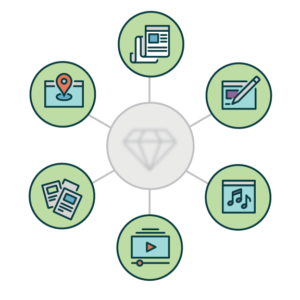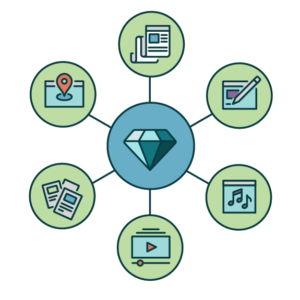What is the Hub and Spoke Content Strategy?
The hub and spoke model is one you’re probably already using whether you realize it or not. The strategy goes like this:
Know Your Audience

First, you have to take into account your audience and their customer journey. What content will they find value in? Once you’ve got this part nailed down, you’ll have a solid roadmap in place for creating and publishing content that will establish a deeper relationship with your audience and establish you as a thought leader in your industry.
Create the Hub

The next order of business is creating your “hub” content. This content is unique, high quality, helpful content that someone would gladly exchange some of their information (name, email address, etc) for. By capturing this contact information, you’ll be able to nurture this new relationship and create a deeper connection, helping your potential new customer move further along in their customer journey. According to Salesforce, 60% of consumers have a more positive perception of a company after engaging with custom content on their site.
Hub content should be helpful, relevant, and valuable to the reader. Things like ebooks, white papers, case studies or webinars are great examples of hub content.
Add the Spokes

The hub is published first, followed by the spokes. Spokes are additional, more digestible pieces of content that are both related to and link back to your hub content. Spoke content can include things like individual blog posts, social media posts, emails, or guest posts on other websites. This content is designed specifically to push traffic back to your hub content to gather contact information from the user.
Generally, spoke content should be deployed for 2-3 months after the hub content is published, but can always be longer or shorter depending on the focus and timeliness of the hub content.
Hub and spoke content go hand in hand to help you engage your audience, nurture leads, and – ultimately – get conversions.
Piece It Together

Your last step is making sure everything connects. Your hub content should provide the appropriate value to generate conversions. In the meantime, your spokes should build awareness, support your expertise, increase your credibility, and drive traffic. If you notice conversions are low, make sure your content offer is actually what your audience wants. Otherwise, you should consider increasing the visibility of your spoke content.
And remember, spokes don’t have to always be content on your website … or even your content for that matter. Partner with other businesses and groups for guest appearances in podcasts, cross-sharing or -posting on social platforms, and external linking from partner websites. All of these spokes work together, regardless of their location on the web.
Three Key Returns from the Hub and Spoke Content Strategy:
- Lead Generation
- Owned Audience Growth
- Increased SEO Value
-
- More relevant keywords
- More backlinks if you’re attempting to pitch content to other sites/sources, or writing guest content
Ideally, a new Hub and Spoke campaign would be generated and launched every quarter. Sticking to this frequency will allow you to quickly grow your resource library of Hub content. This provides your audience with valuable information more frequently, keeping them engaged with your brand.
In addition to lead generation, this strategy has secondary benefits from an SEO perspective. Hub and Spoke strategies provide your site with more keywords and valuable external signals if executed successfully, thus increasing your site’s overall search network credibility, providing additional organic search traffic to the Hub content.
Getting Started
A Hub and Spoke content strategy requires effort and resources. Generating the amount of content suggested is time-consuming and can be an effort on its own. Staying organized in your content creation is essential and thinking through tracking and reporting for the campaign is also critical. But fear not!
Starting with a simple written plan can keep you organized and get things moving. We suggest creating a content outline to gather ideas and organize your content into buckets (or hubs!). Here’s an example that we might implement at Willow:
Hub Content
- Whitepaper – Willow’s Guide to Content Strategy
Spoke Content
- Blog – Hub & Spoke Content Strategy
- Blog – Content Strategy Principles
- Blog – Blending Content Strategy and Earned Media
- Podcast – Content Strategy: Incorporating Earned Media and SEO strategies to take your content to the next level
- Video – Interview with Willow Content Strategist Erin Witt about content strategy and her role
- Conference/Event Page – Better U: Content Strategy 101 – Building effective content strategies and plans for your business
- Infographic – Hub and Spoke content strategy process all the way through lead nurturing and conversion
- Case Study – Client example of effective lead-generation growth through content strategy (may be a little harder to get)
- Social & Email – content written for each of the aforementioned posts to promote them to existing audiences, driving users back to the site and onto the larger Hub Content to gather their information and get them into our funnel.
If you want to get more advanced, you can use a tool such as LucidChart to map out your Hub and Spoke content to visualize how things connect.
Interested in launching a campaign of your own, but aren’t sure where to start (or want to take your campaigns to the next level)? Feel free to reach out to your friendly neighborhood Willow team member and we’d be happy to help!
